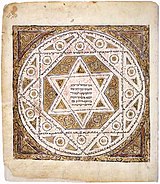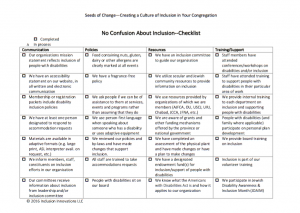For an entire year, my synagoue, Congregation Kneseth Israel has studied covenant. In Hebrew the word is brit. As a concluding activity, we met for a Tikkun Leil Shavuot to figure out what we have learned and how we relate it to living in 5779/2019 and in community. The community of a congregation. A community that takes care of one another. Each month as part of my bulletin announcement I would look at one of the obligations outlines in Elu Devarim, a piece of the Ralmud that is included in the morning service. Then between Passover and Shavuot as part of our Omer Study Project we would look at a section together.
We began Shavuot night with a puzzle, broken into pieces, that had “We shall do and we shall hear.” Scribbled on puzzle pieces were 48 things we “should” do according to the Torah that are Jewish values. 48. Almost the 50 of counting the omer, the 50 days between Passover and Shavuot.
Then we did chevruta study, study in pairs of friendsThere are 346 mentions of covenant in Scripture, a good online concordance will tell you. 270 in the Hebrew Scriptures alone. Many are about the “ark of the covenant.” Those verses we didn’t study. What we did do was study verses from each of the Books of the Torah, some from the Writings and Prophets and some from the Talmud. Those verses follow.
There are several types of covenants in the Bible.
- There is the covenant of creation, of the Garden of Eden where G-d commands Adam and Eve to be fruitful and multiply and that while they have dominion over the earth, they need to be caretakers of the earth and to be G-d’s partner in creation.
- There is the covenant with Noah where G-d promises never to destroy the world again by flood. Out of that, the rabbis deduce 7 Noahide laws. These are covenantal responsibilities for being part of the covenant. G-d’s sign of the covenant is the rainbow.
- Then there was the covenant with Abraham, where G-d promises the land of Israel to Abraham and his descendants and to make his descendants as numerous as the sands of the sea and the stars in the sky. The sign of the covenant is the circumcision, the brit milah.
- The covenant with Moses is given while standing at Mount Sinai. It is reflective of the Abrahamic covenant and described in covenantal language of Exodus 19. It includes the 10 Commandments (or the 613 Commandments). Earlier in the Exodus saga Tziporah circumcises her son (when Moses doesn’t). The sign of the covenant is Torah itself and in some communities is seen as a ketubah marrying G-d and the people of Israel on Shavuot.
- Shabbat is a sign of the covenant that is promised in Exodus 31. We sing this song joyously on Shabbat, V’shamru. We, the children of Israel shall keep the Sabbath…it is a sign for all generations.
And that is what a covenant is. A promise between peoples. If you do x, I will do y. In Hebrew the language is to “cut a covenant”. There a number of combination words about covenant:
- Ot habrit, Sign of the Covenant (rainbow, circumcision, Shabbat)
- Brit Milah, Circumcision of Covenant
- Bnei brit, Children of the Covenant
Luchot habrit, Tablets of the Covenant
- Aron Habrit, Ark of the Covenant
- Sefer habrit, Book of the Covenant
- Dam Habrit, Blood of the covenant
- Brit shalom, Covenant of Peace
- Brit hadashah, New Covenant
- Brit Olam (a political party in Israel and a designation of the Religious Action Center of the Reform Movement)
Brit Shalom fascinates me because the new JPS translation translates it as “covenant of friendship” or “pact of friendship”. I asked my Bar Mitzvah students why they thought that choice was made. They said that they thought it was because without peace you really can’t have friendship. And without friends there is no peace.
Marriage Covenant
“Blessed are You, LORD, our God, sovereign of the universe, who created joy and gladness, groom and bride, mirth, song, delight and rejoicing, love and harmony and peace and companionship. Quickly, LORD our God, there should be heard in the cities of Judah and in the courtyards of Jerusalem the voice of joy and the voice of gladness, the voice of groom and the voice of bride, the jubilant voices of grooms from the bridal canopy, and of young people from the feast of their singing. Blessed are You, LORD, who makes joyful the groom and the bride.”
Shavuot Covenant:
Shavuot is seen as the fulfillment of the covenant. A marriage between G-d and the people of Israel.
God proposes: “Now then, if you will obey Me faithfully and keep My covenant, you shall be My treasured possession among all the peoples” (Exodus 19:5).
The people accept: “All the people answered as one, saying, ‘All that the Eternal has spoken we will do!’” (Exodus 19:8).
The people cleanse themselves, as at a mikvah (Jewish ritual bath, traditionally used by a bride before the wedding): “Moses came down from the mountain to the people and warned the people to stay pure, and they washed their clothes” (Exodus 19:14).
Then God and the people join under a chuppah (marriage canopy): “Moses led the people out of the camp toward God, and they took their places beneath [at the foot of] the mountain. Now Mount Sinai was all in smoke, for the Eternal had come down upon it in fire” (Exodus 19:17-18).
There is a ketubah (marriage contract): “The Eternal said to Moses, “Come up to Me on the mountain and wait there, and I will give you the stone tablets with the teachings and commandments which I have inscribed to instruct them” (Exodus 24:12).
Here is a sample Shavuot Ketubah, written by Israel Najara (c.1550-c.1625)::
Friday, the sixth of Sivan, the day appointed by the Lord for the revelation of the Torah to His beloved people… The Invisible One came forth from Sinai, shone from Seir and appeared from Mount Paran unto all the kings of the earth, in the year 2448 since the creation of the world, the era by which we are accustomed to reckon in this land whose foundations were upheld by God, as it is written, ‘For He hath founded it upon the seas and established it upon the floods’ (Psalms 24.2).
The Bridegroom [God], Ruler of rulers, Prince of princes, Distinguished among the select, Whose mouth is pleasing and all of Whom is delightful, said unto the pious, lovely and virtuous maiden [the people of Israel] who won His favor above all women, who is beautiful as the moon, radiant as the sun, awesome as bannered hosts: Many days wilt thou be Mine and I will be thy Redeemer.
Behold, I have sent thee golden precepts through the lawgiver Jekuthiel [Moses]. Be thou My mate according to the law of Moses and Israel, and I will honor, support, and maintain thee and be thy shelter and refuge in everlasting mercy. And I will set aside for thee, in lieu of thy virginal faithfulness, the life-giving Torah by which thou and thy children will live in health and tranquility.
This bride [Israel] consented and became His spouse. Thus an eternal covenant, binding them forever, was established between them. The Bridegroom then agreed to add to the above all future expositions of Scripture, including Sifra, Sifre, Aggadah, and Tosefta. He established the primacy of the 248 positive commandments that are incumbent upon all… and added to them the 365 negative commandments. The dowry that this bride brought from the house of her father consists of an understanding heart that understands, ears that hearken, and eyes that see.
Thus the sum total of the contract and the dowry, with the addition of the positive and negative commandments, amounts to the following: ‘Revere God and observe His commandments; this applies to all mankind’ (Ecclesiastes 12:13). The Bridegroom, desiring to confer privileges upon His people Israel and to transmit these valuable assets to them, took upon Himself the responsibility of this marriage contract, to be paid from the best portions of His property…
All these conditions are valid and established forever and ever. The Bridegroom has given His oath to carry them out in favor of His people and to enable those that love Him to inherit substance. Thus the Lord has given His oath. The Bridegroom has followed the legal formality of symbolic delivery of this document, which is bigger than the earth and broader than the seas. Everything, then, is firm, clear, and established…
I invoke heaven and earth as reliable witnesses.
May the Bridegroom rejoice with the bride whom He has taken as His lot and may the bride rejoice with the Husband of her youth while uttering words of praise.
“I will betroth thee unto Me for ever; yea, I will betroth thee unto Me in righteousness, and in justice, and in lovingkindness, and in compassion. And I will betroth thee unto Me in faithfulness, and thou shalt know the Lord” (Hosea 2:21-22) and “I will make a new covenant with the house of Israel” (Jeremiah 31:31)
And here Is the culminating exercise, how we took the year’s study of covenant and created our own Shavuot ketubah for Congregation Kneseth Israel, mirroring our vision statement with Elu Devarim :
“The Israelites
gathered at the foot of Mount Sinai said “We will do and we will hear.” Even before they knew what was in it, they agreed.
On this, the 6th of Sivan 5779 as we reckon time in Elgin, IL, we, the members of Congregation Kneseth Israel are standing again at Mount Sinai ready to receive the Torah as a sign of our covenant with the Holy One. We promise to engage in
Lifelong Learning
To attend the house of study
To learn and to teach with our adults and children
To teach our children diligently
Meaningful Observance
To pray with sincerity
To remember and keep Shabbat
To rejoice with bride and groom
To console the bereaved
To celebrate lifecycle events and holidays
To maintain a kosher kitchen
Building Community
To honor our fathers and mothers
To perform acts of love and kindness
To visit the sick
To host gatherings for men and women and children
To be warm and welcoming to all who enter
Embracing Diversity
To recognize that everyone is created in the image of G-d, b’tzelem elohim
To love our neighbors as ourselves
To welcome the stranger
To provide hospitality to all who enter
To not put a stumbling block before the blind or curse the deaf
To provide a safe, non-judgmental space for all to learn, celebrate and grow
To make peace where there is strife
And the study of Torah equal to them all, because it leads to them all.
“Ours is not to finish the task, neither are we free to ignore it.” Pirke Avot 2:21
Witnessed and signed this day of Shavuot, 5779 by the members of Congregation Kneseth Israel
Here are the chevruta texts we used:
Genesis
“And I will remember My covenant, which is between Me and you and every living creature of all flesh; and never again shall the water become a flood to destroy all flesh.” (Gen. 9:15)
“When the bow is in the cloud, then I will look upon it, to remember the everlasting covenant between God and every living creature of all flesh that is on the earth.” (Gen 9:16)
On the same day the LORD made a covenant with Abram, saying, Unto your seed have I given this land, from the river of Egypt unto the great river, the river Euphrates: (Gen. 15:18)
“As for me, behold, my covenant is with you, and you shalt be a father of many nations.” (Genesis 17:4)
“And I will establish my covenant between me and you and your seed after you in their generations for an everlasting covenant, to be a God unto you, and to your seed after you.” (Genesis 17:7)
And God said, Sarah your wife shall bear you a son indeed; and you shall call his name Isaac: and I will establish my covenant with him for an everlasting covenant, and with his seed after him. But my covenant will I establish with Isaac, which Sarah shall bear unto you at this set time in the next year. (Gen. 17:19, 21)
“And Abraham took sheep and oxen, and gave them to Abimelech; and both of them made a covenant.” Genesis 21:27
“So now come, let us make a covenant, you and I, and let it be a witness between you and me.” (Genesis 31:44) (between Jacob and Laban)
Exodus
“So God heard their groaning; and God remembered God’s covenant with Abraham, Isaac, and Jacob.” (Exodus 2:24)
“I also established My covenant with them, to give them the land of Canaan, the land in which they sojourned. (Exodus 6:4)
“Furthermore I have heard the groaning of the children of Israel, because the Egyptians are holding them in bondage, and I have remembered My covenant.” (Exodus 6:5)
“Now therefore, if you will listen to My voice indeed, and keep My covenant, then you shall be My treasure to me from among all people: for all the earth is Mine. And you shall be to Me a kingdom of priests and a holy nation. (Exodus 19:5-6).
“The children of Israel shall keep the Sabbath, observing the Sabbath throughout the ages as a covenant for all time: it shall be a sign for all time between Me and the people of Israel” (Exodus 31:16)
Then God said, “Behold, I am going to make a covenant Before all your people I will perform miracles which have not been produced in all the earth nor among any of the nations; and all the people among whom you live will see the working of the LORD, for it is a fearful thing that I am going to perform with you. (Exodus 34:10)
Leviticus
“You should be holy because I the Lord your G-d am holy.” (Leviticus 19:2)
“Fear (or revere) your mother and your father, because I the Lord your G-d am holy.” (Leviticus 19:3).
“And you shall take fine flour and bake twelve loaves…and you shall set them in two rows, six in a row, upon the pure table before the LORD…every Sabbath day he shall set it in order before the Lord continually, it is from the children of Israel, an everlasting covenant.” (Leviticus 23:6-8)
“then I will remember My covenant with Jacob, and I will remember also My covenant with Isaac, and My covenant with Abraham as well, and I will remember the land.” (Leviticus 26:22)
“Then will I remember my covenant with Jacob, and also my covenant with Isaac, and also my covenant with Abraham will I remember; and I will remember the land.” (Leviticus 26:42)
“But I will for their sakes remember the covenant of their ancestors, whom I brought forth out of the land of Egypt in the sight of the heathen, that I might be their God: I am the LORD. (Leviticus 26:45)
Numbers
“Wherefore say, Behold, I give unto him my covenant of peace and it shall be unto him, and to his seed after him, the covenant of an everlasting priesthood.” (Numbers 25:12-13)
Deuteronomy
And G-d declared to you G-d’s covenant, which the Lord commanded you to perform, even ten commandments; and G-d wrote them upon two tables of stone. (Deut. 4:13)
For the LORD your God is a merciful God; God will not forsake you, nor destroy you, nor forget the covenant of your ancestors which God swore unto them. (Deut 4:31)
“The LORD did not make this covenant with our ancestors, but with us, with all those of us alive here today. (Deut. 5:3)
“So keep the words of this covenant to do them, that you may prosper in all that you do. (Deut. 29:9)
I call heaven and earth to witness against you this day: I have put before you life and death, blessing and curse: Choose life if you and your offspring would live” (Deuteronomy 30:19)
The Lord goes before you and will be with you; God will never leave you nor forsake you. Do not be afraid; do not be discouraged. (Deut. 31:8)
Covenant in Other Books of the TaNaCH
“There is no God like You, in heaven above, or on earth beneath; who keeps the covenant and lovingkindness with Your servants, that walk with Your with all their heart.” (I Kings 8:23)
“The covenant that I have made with you, you shall not forget, nor shall you fear other gods. (II Kings 17:38)
They shall not hurt nor destroy in all My holy mountain; for the earth shall be full of the knowledge of the LORD, as the waters cover the sea.” (Isaiah 11:8)
I the LORD have called you to righteousness, and will hold your hand, and will keep you, and give you a covenant of the people, for a light of the nations.” (Isaiah 42:6).
“When you pass through the waters, I will be with you; and when you pass through the rivers, they will not sweep over you. When you walk through the fire, you will not be burned; the flames will not set you ablaze.” (Isaiah 43:2)
Thus says the LORD, “In a favorable time I have answered You, And in a day of salvation I have helped You; And I will keep You and give You for a covenant of the people, To restore the land, to make them inherit the desolate heritages; (Isaiah 49:8)
“For the mountains may be removed and the hills may shake, But My lovingkindness will not be removed from you, And My covenant of peace will not be shaken,” Says the LORD who has compassion on you.” (Isaiah 54:10)
“As for Me, this is My covenant with them,” says the LORD: “My Spirit which is upon you, and My words which I have put in your mouth shall not depart from your mouth, nor from the mouth of your offspring, nor from the mouth of your offspring’s offspring,” says the LORD, “from now and forever.” (Isaiah 59:21)
“But I will make a new covenant with the whole nation of Israel after I plant them back in the land,” says the Lord. “I will put my law within them and write it on their hearts and minds. I will be their God and they will be my people.” (Jeremiah 31:33)
“I will make an everlasting covenant with them that I will not turn away from them, to do them good; and I will put the fear of Me in their hearts so that they will not turn away from Me. (Jeremiah 32:40)
“Thus says the LORD, ‘If My covenant for day and night stand not, and the fixed patterns of heaven and earth I have not established. (Jeremiah 33:35)
And on that day will I make a covenant with them with the beasts of the field, and with the birds of heaven, and with the creeping things of the ground; and I will break the bow and the sword and the battle out of the land, and will make them to lie down safely. (Hosea 2: 20)
“To do justly, love mercy and walk humbly with your G-d.” (Micah 6:8)
“I will make a covenant of peace with them; it will be an everlasting covenant with them. And I will place them and multiply them, and will set My sanctuary in their midst forever. (Ezekiel 37:26)
“My covenant with him was one of life and peace, and I gave them to him as an object of reverence; so he revered Me and stood in awe of My name. (Malachi 2:5)
“Truly is not my house so with God? For He has made an everlasting covenant with me, Ordered in all things, and secured; For all my salvation and all my desire, Will He not indeed make it grow? (2 Samuel 23:5)
“I have made a covenant with My chosen; I have sworn to David My servant, I will establish your seed forever And build up your throne to all generations.” Selah. (Psalm 89:3-4)
My mercy will I keep for him for evermore, and my covenant shall stand fast with him. (Psalm 89:28)
“The Lord has remembered God’s covenant forever, The word which God commanded to a thousand generations,” (Psalm 105:8)
Covenant in the Talmud:
These are the obligations without measure, whose reward too, is without measure: whose fruits we eat in this world, but whose full reward awaits us in the World to Come:
To honor father and mother;
To perform acts of love and kindness;
To attend the house of study daily;
To welcome the stranger;
To visit the sick;
To rejoice with bride and groom;
To console the bereaved;
To pray with sincerity;
To make peace when there is strife;
And the study of Torah equal to them all, because it leads to them all.
Mishnah Peah 1:1
The Talmud tells this story about a Sadducee who once saw Rava so engrossed in learning that he did not attend a wound in his own hand! The Sadducee exclaimed, “You rash people! You put your mouths ahead of your ears [by saying “we will do and we will listen”]! and you still persist in your recklessness. First, you should have heard out [the covenant details]. If it is within your powers, then accept it. If not, you should have rejected it!” Rava answered, “We walked with our whole being. [Rashi’s classic Talmudic commentary: “We walked…as those who serve (God) in love. We relied on God not to burden us with something we could not carry. “] Of us it is written, ‘The wholeness (meaning wholeheartedness) of the righteous shall guide them.’” [Babylonian Talmud, Shabbat, 88a.]



